Hydrogen Production by Water Electrolysis with Low Power and High Efficiency Based on Pre-Magnetic Polarization
Abstract
:1. Introduction
2. Theoretical Analyses
3. Experimental
3.1. Experimental Equipment
3.2. Experimental Process
4. Results and Discussion
4.1. Conductivity Change Inmagnetic Polarized Water
4.2. Change in Current Density and Actual Inter-Electrode Voltage in Magnetic Polarized Water in PEM Electrolyzer
4.3. Hydrogen Production Rate and Energy Consumption
5. Conclusions
Author Contributions
Funding
Data Availability Statement
Conflicts of Interest
References
- Zhan, S.Q.; Huang, Y.J.; Wang, J.F. Experimental study on bubble growth characteristics on horizontal microcelectrode surface in vertical magnetic field. J. Cent. South Univ. Sci. Technol. 2021, 52, 249–258. [Google Scholar] [CrossRef]
- Mao, Z.Q.; Mao, Z.M.; Yu, H. Hydrogen Production Process and Technology; Chemical Industry Press: Beijing, China, 2018. [Google Scholar]
- Wang, M.G.; Wang, Z.; Guo, Z.C. Water electrolysis enhanced by super gravity field for hydrogen producting. Int. J. Hydrogen Energy 2010, 35, 3198–3205. [Google Scholar] [CrossRef]
- Lin, M.Y.; Hourng, L.W. Ultrasonic wave field effects on hydrogen production by water electrolysis. J. Chin. Inst. Eng. 2014, 237, 1080–1089. [Google Scholar] [CrossRef]
- Taqieddin, A.; Nazari, R.; Rajic, L. Review: Physicochemical hydrodynamics of gas bubbles in two phase electrochemical systems. J. Electrochem. Soc. 2017, 164, E448–E459. [Google Scholar] [CrossRef] [PubMed]
- Bidin, N.; Azni, S.R. The effect of magnetic and optic field in water electrolysis. Int. J. Hydrogen Energy 2017, 42, 16325–16332. [Google Scholar] [CrossRef]
- Purnami; Hamidi, N.; Sasongko, M.N.; Widhiyanuriyawan, D.; Wardana, I.N.G. Strengthening external magnetic fields with activated carbon graphene for increasing hydrogen production in water electrolysis. Int. J. Hydrogen Energy 2020, 45, 19370–19380. [Google Scholar] [CrossRef]
- Nieminen, J.O.; Voigt, J.; Hartwig, S. Improved contrast in ultra-low-field MRI with time-dependent bipolar prepolarizing fields: Theory and NMR demonstrations. Metrol. Meas. Syst. 2013, 20, 327–336. [Google Scholar] [CrossRef] [Green Version]
- Chizhik, V.I.; Kupriyanov, P.A.; Mozzhukhin, G.V. NMR in magnetic field of the earth: Pre-polarization of nuclei with alternating magnetic field. Appl. Magn. Reson. 2014, 45, 641–651. [Google Scholar] [CrossRef]
- Iida, T.; Matsushima, H.; Fukunaka, Y. Water electrolysis under a magnetic field. J. Electrochem. Soc. 2007, 154, E112–E115. [Google Scholar] [CrossRef]
- He, X.K. Research on the Ineluence of External Magnetic Field on the Electrolytic Efficiency of Oxyy-Hydrogen Generator; Harbin Institute of Technology: Harbin, China, 2015. [Google Scholar]
- Jing, S.; Hu, H.; Wang, S. Design of pulsed power supply for repetitive pulsed high magnetic field for water electrolysis. Rev. Sci. Instrum. 2021, 92, 114708. [Google Scholar] [CrossRef] [PubMed]
- Matsushima, H.; Iida, T.; Fukunaka, Y. Gas bubble evolution on transparent electrode during water electrolysis in a magnetic field. Electrochim. Acta 2013, 100, 261–264. [Google Scholar] [CrossRef]
- Kaya, M.F.; Demir, N.; Rees, N.V.; El-Kharouf, A. Improving PEM water electrolyser’s performance by magnetic field application. Appl. Energy 2020, 264, 114721. [Google Scholar] [CrossRef]
- Costa, C.M.; Merazzo, K.J.; Goncalves, R. Magnetically active lithium-ion batteries towards battery performance improvement. Iscience 2021, 24. [Google Scholar] [CrossRef] [PubMed]
- Zhang, Y.X.; Fan, L.; Li, X.G. Effect of Alternating Magnetic Field on Electrochemical Behavior of 316L and TA2 in Simulated Seawater. J. Mater. Eng. Perform. 2021, 30, 9377–9389. [Google Scholar] [CrossRef]
- Yin, Y.; Huang, G.; Tong, Y.; Liu, Y.; Zhang, L. Electricity production and electrochemical impedance modeling of microbial fuel cells under static magnetic field. J. Power Sources 2013, 237, 58–63. [Google Scholar] [CrossRef]
- Lin, M.Y.; Hourng, L.W.; Kuo, C.W. The effect of magnetic force on hydrogen production efficiency in water electrolysis. Int. J. Hydrogen Energy 2012, 37, 1311–1320. [Google Scholar] [CrossRef]
- Deng, B.; Pang, X.F. Static Magnetic Field Influence on Properties of Water. J. Univ. Electron. Sci. Technol. China 2008, 37, 959–962. [Google Scholar]
- Zheng, B.M.; Chen, Y.G.; Qian, G.Y.; Gong, X.Z.; Wang, Z. Enhancement mechanism of high strength circulating magnetic field on electrodeposition of low concentration copper ion solution. Min. Metall. 2021, 3, 109–115. [Google Scholar] [CrossRef]
- Pietra, A.; Gianni, M.; Zuliani, N.; Malabotti, S.; Taccani, R. Experimental Characterization of an Alkaline Electrolyser and a Compression System for Hydrogen Production and Storage. Energies 2021, 14, 5347. [Google Scholar] [CrossRef]
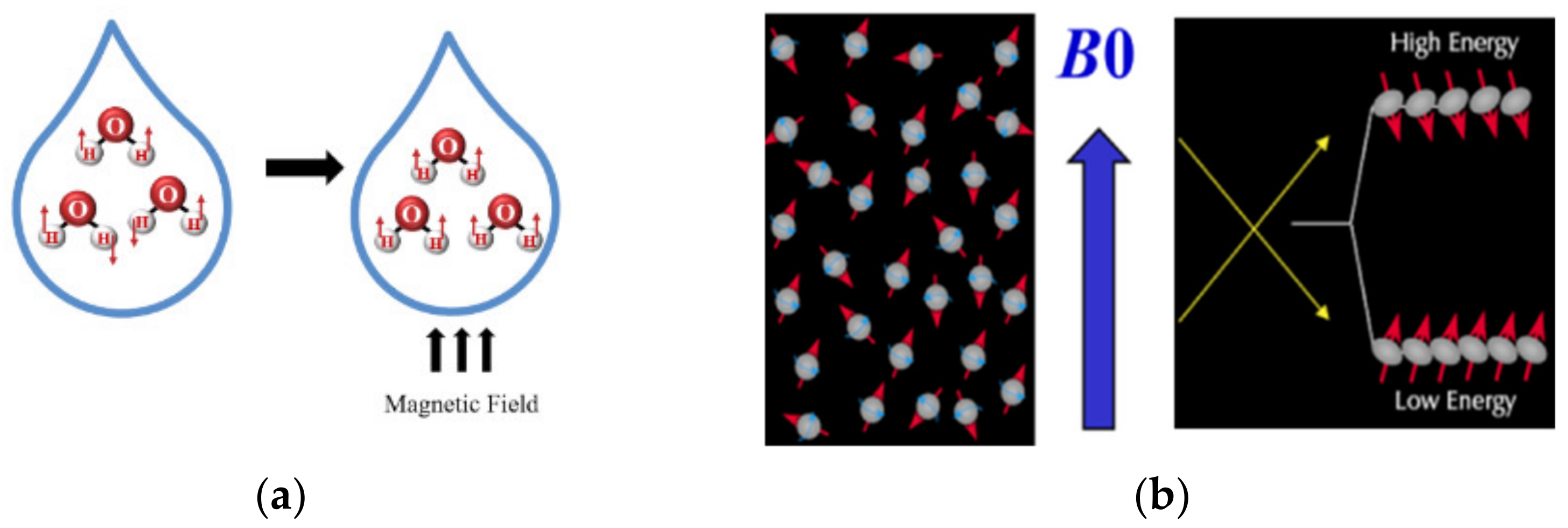

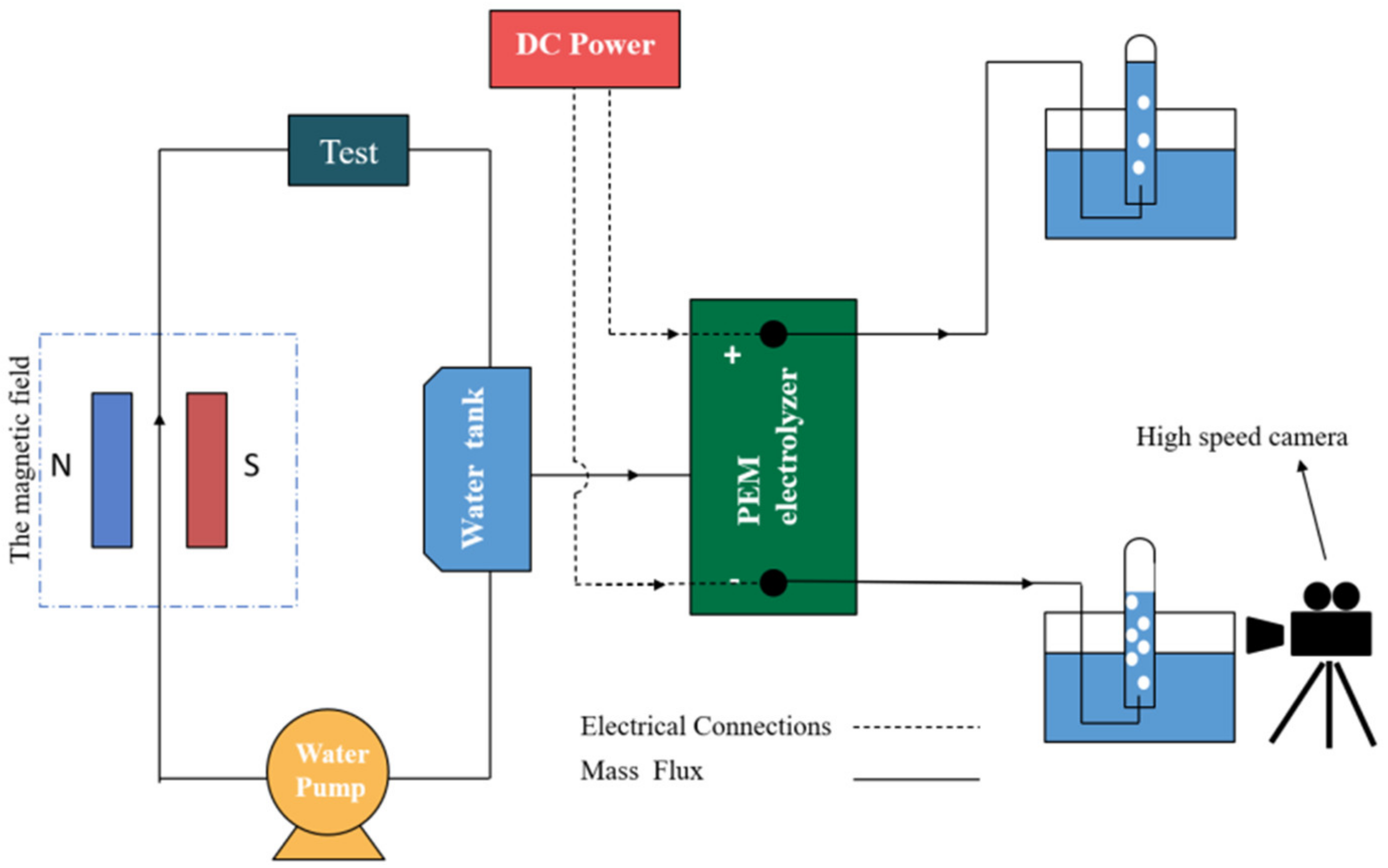
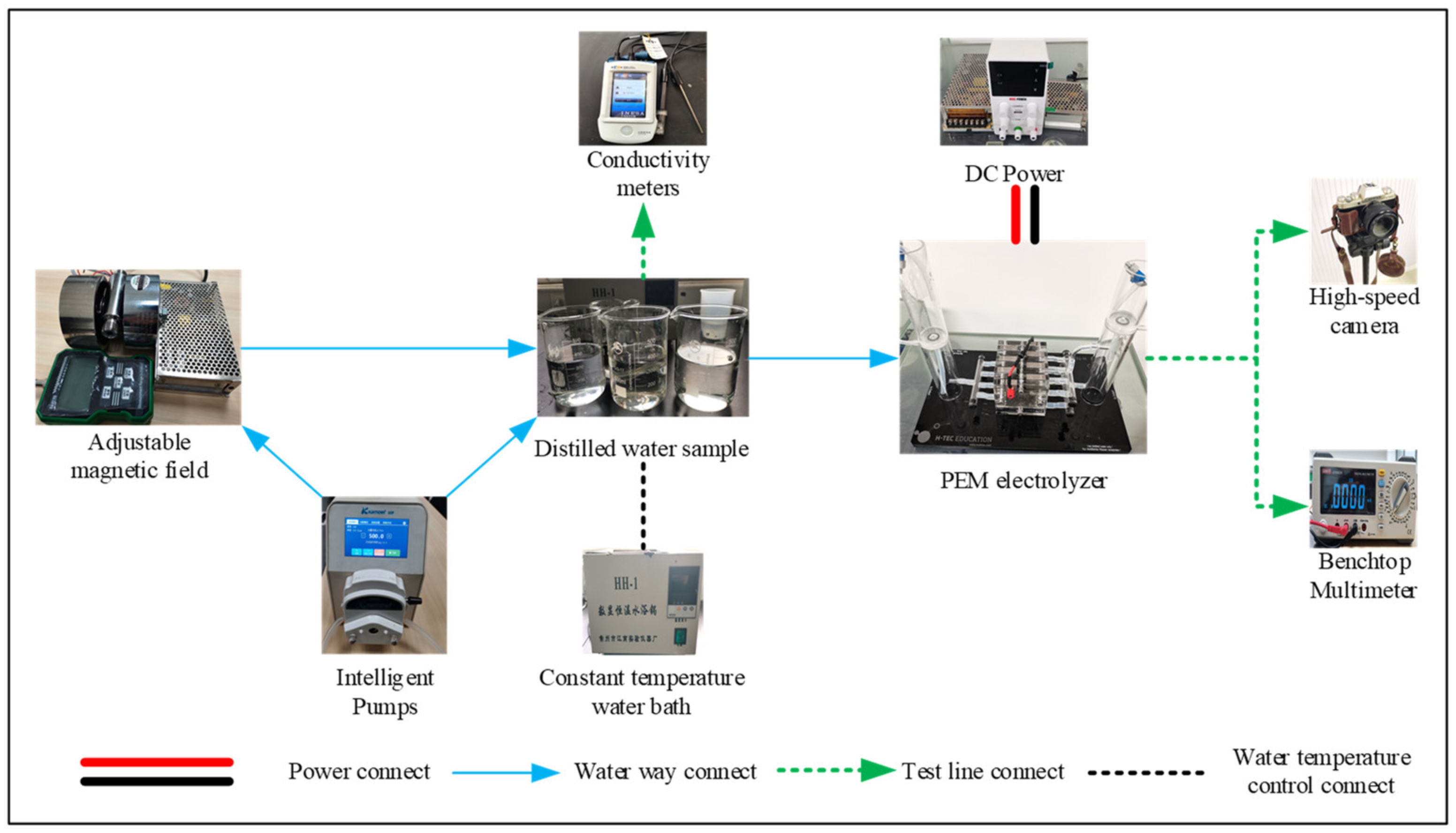
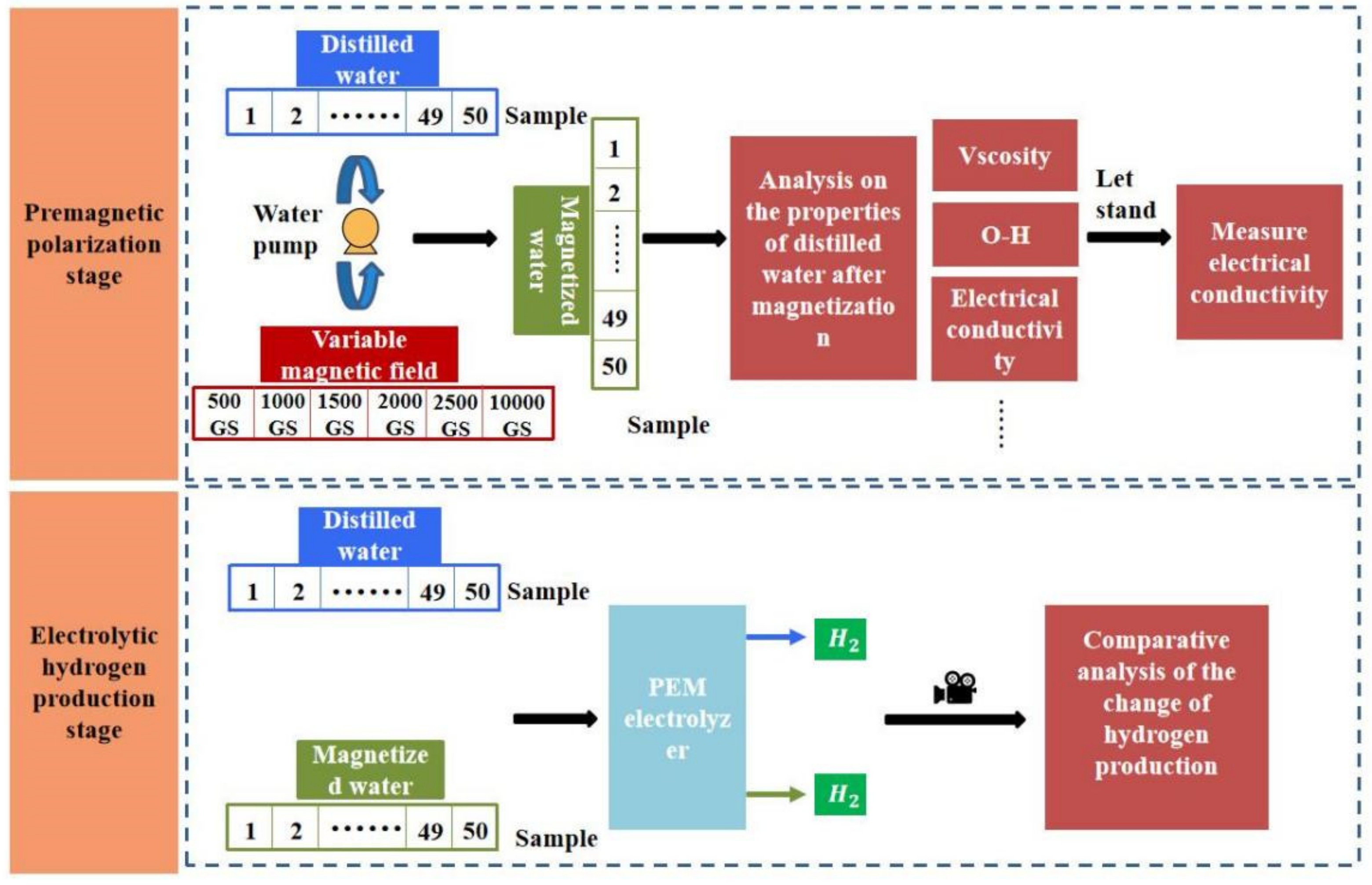



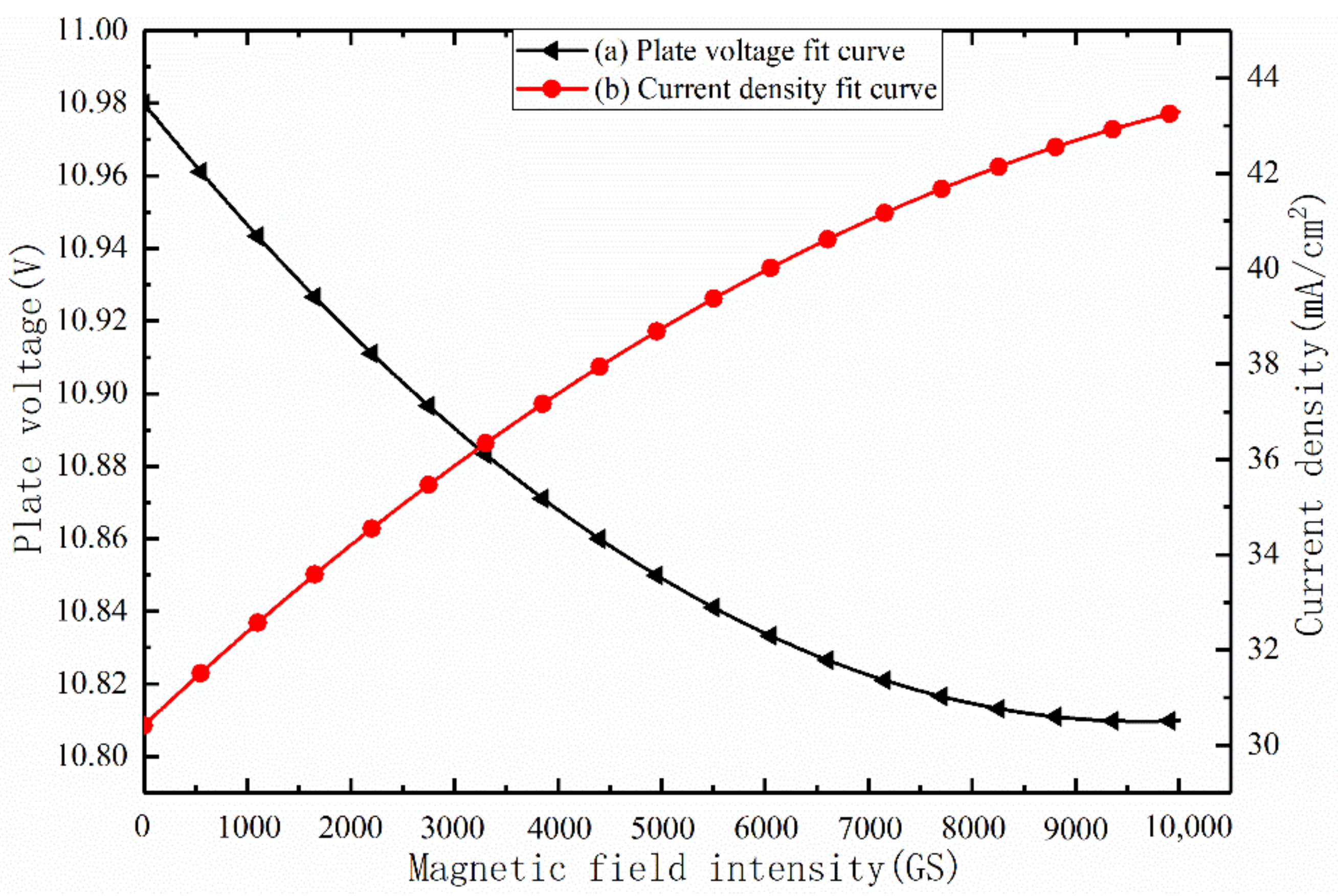

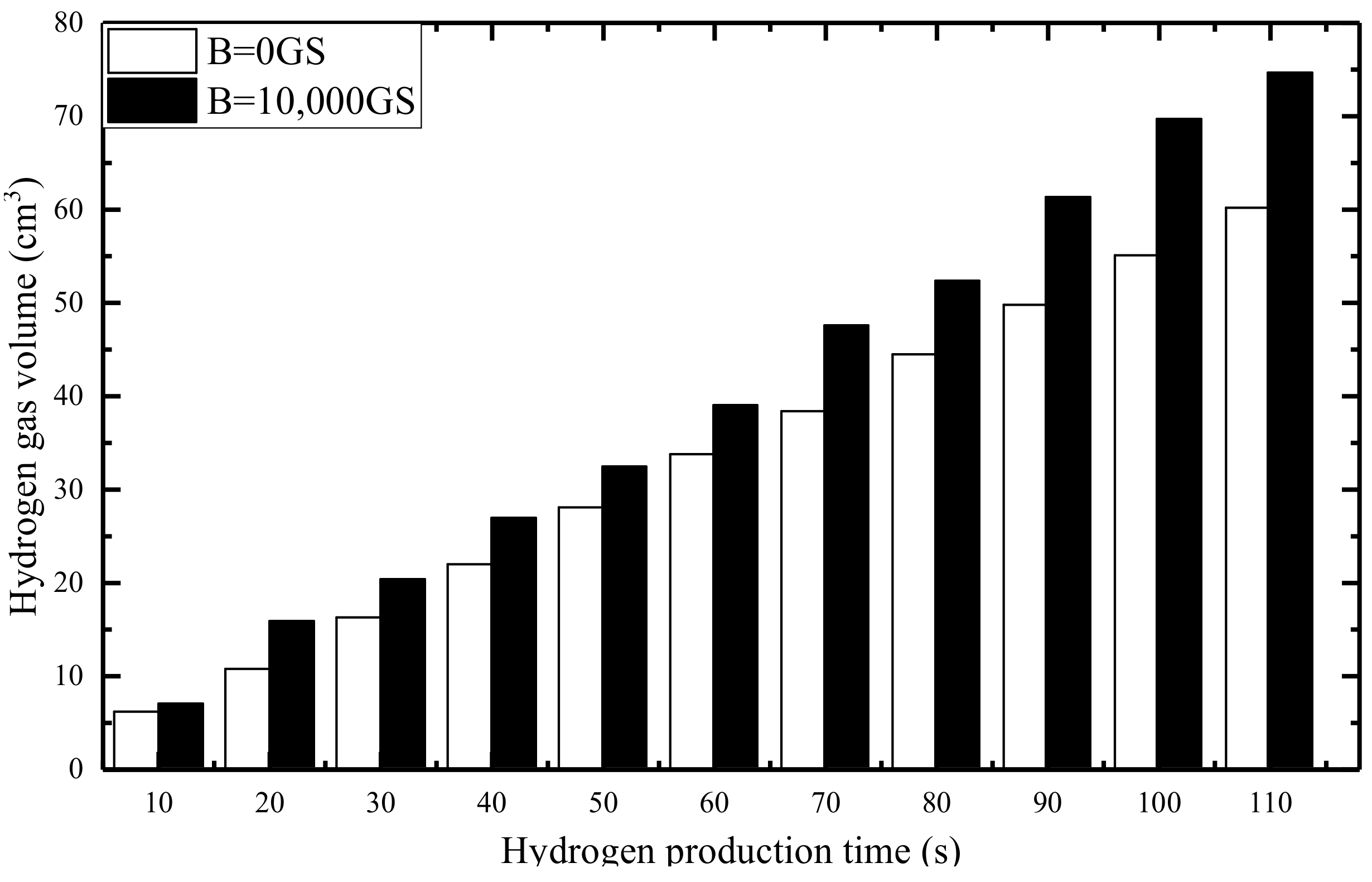
| Magnetization Time (min) | ||||||||
|---|---|---|---|---|---|---|---|---|
| 0 | 5 | 10 | 15 | 20 | 25 | 30 | 35 | |
| Magnetic Field Intensity (GS) | Uncertainty of Conductivity Change (%) | |||||||
| 500 | 0.61 | 0.46 | 0.58 | 0.91 | 0.79 | 0.77 | 0.63 | 0.56 |
| 1000 | 0.86 | 0.38 | 0.78 | 0.92 | 0.85 | 0.72 | 0.64 | 0.68 |
| 1500 | 0.59 | 0.63 | 0.52 | 0.89 | 0.42 | 0.49 | 0.69 | 0.62 |
| 2000 | 0.67 | 0.71 | 0.59 | 0.57 | 0.75 | 0.66 | 0.87 | 0.52 |
| 2500 | 0.44 | 0.39 | 0.49 | 0.63 | 0.87 | 0.94 | 0.74 | 0.76 |
| 10,000 | 0.72 | 0.74 | 0.87 | 0.65 | 0.56 | 0.89 | 0.92 | 0.56 |
| Hydrogen Production Time (s) | ||||||||
|---|---|---|---|---|---|---|---|---|
| 10 | 20 | 40 | 60 | 80 | 90 | 100 | 110 | |
| Magnetic Field Intensity (GS) | Uncertainty of Hydrogen Volume (%) | |||||||
| 500 | 1.63 | 1.78 | 2.02 | 1.97 | 2.14 | 1.53 | 2.34 | 1.63 |
| 1000 | 1.52 | 1.38 | 2.21 | 2.03 | 1.69 | 2.54 | 1.14 | 1.83 |
| 1500 | 1.49 | 2.31 | 1.39 | 2.19 | 2.63 | 1.84 | 1.58 | 2.93 |
| 2000 | 1.69 | 1.47 | 1.76 | 2.63 | 3.04 | 2.93 | 2.79 | 1.73 |
| 2500 | 1.75 | 1.39 | 2.64 | 1.98 | 1.67 | 1.64 | 2.38 | 2.89 |
| 10,000 | 1.32 | 2.12 | 1.96 | 2.07 | 2.37 | 1.79 | 2.25 | 2.34 |
| 0 GS | 10,000 GS | |
|---|---|---|
| Hydrogen Volume (cm3) | Power Consumption (kW·h) | |
| 10 | 0.04273 | 0.03148 |
| 20 | 0.08323 | 0.06091 |
| 40 | 0.15579 | 0.13242 |
| 60 | 0.23058 | 0.19961 |
Publisher’s Note: MDPI stays neutral with regard to jurisdictional claims in published maps and institutional affiliations. |
© 2022 by the authors. Licensee MDPI, Basel, Switzerland. This article is an open access article distributed under the terms and conditions of the Creative Commons Attribution (CC BY) license (https://creativecommons.org/licenses/by/4.0/).
Share and Cite
Li, K.; Zhang, H.; Zheng, X.; Liu, C.; Chen, Q. Hydrogen Production by Water Electrolysis with Low Power and High Efficiency Based on Pre-Magnetic Polarization. Energies 2022, 15, 1878. https://doi.org/10.3390/en15051878
Li K, Zhang H, Zheng X, Liu C, Chen Q. Hydrogen Production by Water Electrolysis with Low Power and High Efficiency Based on Pre-Magnetic Polarization. Energies. 2022; 15(5):1878. https://doi.org/10.3390/en15051878
Chicago/Turabian StyleLi, Ke, Heng Zhang, Xiaoyu Zheng, Chang Liu, and Qianding Chen. 2022. "Hydrogen Production by Water Electrolysis with Low Power and High Efficiency Based on Pre-Magnetic Polarization" Energies 15, no. 5: 1878. https://doi.org/10.3390/en15051878
APA StyleLi, K., Zhang, H., Zheng, X., Liu, C., & Chen, Q. (2022). Hydrogen Production by Water Electrolysis with Low Power and High Efficiency Based on Pre-Magnetic Polarization. Energies, 15(5), 1878. https://doi.org/10.3390/en15051878










